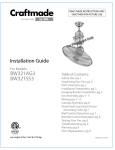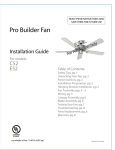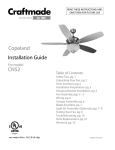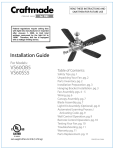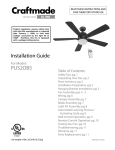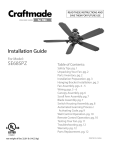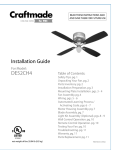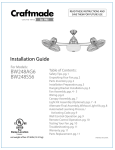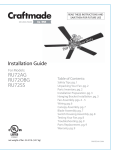Download Craftmade BW321AG3 Installation guide
Transcript
READ THESE INSTRUCTIONS AND SAVE THEM FOR FUTURE USE . ly O . P F. t On en m e lac P r Fo Installation Guide For Models: BW321AG3 BW321SS3 Table of Contents: Safety Tips. pg. 1 Unpacking Your Fan. pg. 2 Parts Inventory. pg. 2 Installation Preparation. pg. 3 Hanging Bracket Installation. pg. 3 Fan Assembly. pgs. 4 - 5 Wiring. pgs. 5 - 6 Canopy Assembly. pg. 6 Automated Learning Process/ Activating Code. pg. 7 Wall Control Operation. pg. 7 Remote Control Operation. pg. 8 Testing Your Fan. pg. 8 Troubleshooting. pg. 9 Warranty. pg. 9 Parts Replacement. pg. 9 E192641 net weight of fan: 15.63 lb (7.09 kg) PRINTED IN CHINA SAFETY TIPS. WARNING: To reduce the risk of electrical shock, turn off the electricity to the fan at the main fuse box or circuit panel before you begin the fan installation or before servicing the fan or installing accessories. 1. READ ALL INSTRUCTIONS AND SAFETY INFORMATION CAREFULLY BEFORE INSTALLING YOUR FAN AND SAVE THESE INSTRUCTIONS. CAUTION: To avoid personal injury, the use of gloves may be necessary while handling fan parts with sharp edges. 2. Make sure all electrical connections comply with Local Codes or Ordinances, the National Electrical Code, and ANSI/NFPA 70-1999. If you are unfamiliar with electrical wiring or if the house/building wires are different colors than those referred to in the instructions, please use a qualified electrician. 3. Make sure you have a location selected for your fan that allows clear space for the fan and at least ten (10) feet (3.05 meters) of clearance between the floor and the fan cage. The fan should be mounted so that the edges of the fan cage are at least thirty (30) inches (76 centimeters) from walls or other upright structures. 4. The outlet box and ceiling support joist used must be securely mounted, and capable of supporting at least 35 pounds (16 kilograms). The outlet box must be supported directly by the building structure. Use only CUL (Canada) or UL (USA) listed outlet boxes marked "FOR FAN SUPPORT." WARNING: To reduce the risk of fire, electrical shock, or personal injury, mount to the outlet box marked "Acceptable for Fan Support of 15.9 kg (35 lb) or less," and use the mounting screws provided with the outlet box. Most outlet boxes commonly used for the support of lighting fixtures are not acceptable for fan support and may need to be replaced. Consult a qualified electrician if in doubt. WARNING: To reduce the risk of fire, electrical shock, or personal injury, wire connectors provided with this fan are designed to accept only one12 gauge house wire and two lead wires from the fan. If your house wire is larger than 12 gauge or there is more than one house wire to connect to the corresponding fan lead wires, consult an electrician for the proper size wire connectors to use. WARNING: If using this fan in a DAMP location, this fan must be connected to a supply circuit that is protected by a Ground Fault Circuit Interrupter (GFCI) to reduce the risk of personal injury, electrical shock or death. 5. 6. 7. Electrical diagrams are for reference only. After installation is complete, check that all connections are absolutely secure. After making electrical connections, spliced conductors should be turned upward and pushed carefully up into the outlet box. The wires should be spread apart with the grounded conductor and the equipment-grounding conductor on opposite sides of the outlet box. WARNING: To reduce the risk of electrical shock or fire, do not use this fan with any solid state speed control device or control fan speed with a full range dimmer switch. [Using a full range dimmer switch to control fan speed will cause a loud humming noise from fan.] 8. Do not insert anything between the fan blades while they are rotating. WARNING: To reduce the risk of personal injury, do not bend or alter the fan cage during assembly or after installation. Do not insert objects into the path of the blades. WARNING: To avoid personal injury or damage to the fan and other items, be cautious when working around or cleaning the fan. 9. Do not use water or detergents when cleaning the fan or fan blades. A dry dust cloth or lightly dampened cloth will be suitable for most cleaning. WARNING: To reduce the risk of personal injury, use only parts provided with this fan. The use of parts OTHER than those provided with this fan will void the warranty. NOTE: The important safety precautions and instructions appearing in the manual are not meant to cover all possible conditions and situations that may occur. It must be understood that common sense and caution are necessary factors in the installation and operation of this fan. page 1 1. Unpacking Your Fan. Carefully open the packaging. Remove items from Styrofoam inserts. Remove motor assembly and place on carpet or Styrofoam to avoid damage to finish. Do not discard fan carton or Styrofoam inserts should this fan need to be returned for repairs. Check against parts inventory that all parts have been included. 2. Parts Inventory. a. canopy. 1 piece a b c d e f i j b. hanging bracket. 1 piece c. 4½in. downrod and hanging ball. 1 piece d. remote control receiver. 1 piece e. wall control and plate. 2 separate pieces g f. remote control transmitter. 1 piece h g. canopy cover (in hardware pack or pre-attached to canopy). 1 piece h. safety cable (already attached to motor). 1 piece i. motor assembly. 1 piece j. yoke cover. 1 piece k. hardware packs k w/ wall control IMPORTANT REMINDER: You must use the parts provided with this fan for proper installation and safety. page 2 w/ remote 12ft. - 20ft. (3.66m - 6.1m) 3. Installation Preparation. blade edge To prevent personal injury and damage, ensure that the hanging location of the fan allows the fan cage a clearance of 10 feet (3.05m) from the floor and that the edges of the fan cage will be at least 30in. (76 cm) from any wall or obstruction. This fan is suitable for room sizes up to 400 square feet (37.2 square meters). This fan can be mounted with a downrod on a regular (no-slope) ceiling ONLY. Fan CANNOT mount as a flushmount installation NOR on a vaulted ceiling. Installation requires these tools: Phillips screwdriver, flathead screwdriver, adjustable pliers or wrench, stepladder, wire cutters, and rated electrical tape. 30 10 feet inches (3.05m) (76cm) 12ft. - 20ft. (3.66m - 6.1m) downrod installation flushmount installation CANNOT be installed on angled or vaulted ceilings 4. Hanging Bracket Installation. Turn off circuit breakers to current fixture from breaker panel and be sure operating light switch is turned to the OFF position. WARNING: Failure to disconnect power supply prior to installation may result in serious injury. ON ON OFF OFF Remove existing fixture. WARNING: When using an existing outlet box, be sure the outlet box is securely attached to the building structure and can support the full weight of the fan. Ensure outlet box is clearly marked "Suitable for Fan Support." If not, it must be replaced with an approved outlet box. Failure to do so can result in serious injury. CAUTION: Be sure outlet box is grounded properly and that a ground wire (GREEN or bare) is present. Install hanging bracket to outlet box using original screws, spring washers and flat washers provided with new or original outlet box.* Arrange electrical wiring around the back of the hanging bracket and away from the hanging bracket opening. *Note: It is very important that you use the proper hardware when installing the hanging bracket as this will support the fan. page 3 hanging bracket flat washers spring washers outlet box screws 5. Fan Assembly. If you wish to extend the hanging length of your fan, you must remove the hanging ball from the 4½in. downrod provided to use with an extended downrod (sold separately). [If you wish to use the 4½in. downrod, please proceed to instructions following the dotted line below.] set screw hole set screw stop pin hanging ball To remove hanging ball, loosen set screw on hanging ball, lower hanging ball and remove stop pin. Slide hanging ball off the original downrod, A, and slide it down the longer downrod, B (the top of the downrod should be noted as having a set screw hole; use this hole when setting the set screw). Insert stop pin into top of extended downrod and raise hanging ball. Be sure stop pin aligns with slots on the inside of the hanging ball. Tighten set screw securely. A B electrical wiring Tip: To prepare for threading electrical wires through downrod, apply a small piece of electrical tape to the ends of the electrical wires--this will keep the wires together when threading them through the downrod. safety cable downrod canopy Locate canopy cover in hardware pack. [Note: If canopy cover is pre-attached to canopy, remove by turning canopy cover counterclockwise.] Loosen yoke set screws and nuts in yoke at top of motor assembly and remove pin and clip from yoke. Slide downrod through canopy, canopy cover* and yoke cover. *NOTE: Canopy cover must be turned with shiny side toward the motor assembly. canopy cover yoke cover yoke set screw and nut clip pin Thread safety cable and electrical wires through downrod and pull extra wire slack from the upper end of the downrod. motor assembly Thread downrod into yoke in motor assembly until holes for pin and clip in downrod align with holes in yoke--make sure wires do not get twisted. Securely tighten yoke set screws and nuts. Lower yoke cover to motor assembly. NOTE: The important safety precautions and instructions appearing in the manual are not meant to cover all possible conditions and situations that may occur. It must be understood that common sense and caution are necessary factors in the installation and operation of this fan. page 4 5. Fan Assembly. (cont.) With the hanging bracket secured to the outlet box and able to support the fan, you are now ready to hang your fan. Grab the fan firmly with two hands. Slide downrod through opening in hanging bracket and let hanging ball rest on the hanging bracket. Turn the hanging ball slot until it lines up with the hanging bracket tab. safety cable loop wood ceiling joist wood screw and washer safety cable WARNING: Failure to align slot in hanging ball with tab in hanging bracket may result in serious injury or death. hanging bracket tab hanging ball slot IMPORTANT: Seek the help of another person to hold the stepladder in place and to then help lift the fan up to you once you are set on the ladder. canopy Find a secure attachment point (wood ceiling joist highly recommended) and secure safety cable. It will be necessary to use a heavy duty wood screw, washer and lock washer (not supplied) with the safety cable loop. If necessary, adjust the loop at the end of the safety cable. The loop at the end of the safety cable should just fit over the threads on the wood screw. Extra cable slack can be left in ceiling area. motor assembly 6. Wiring. white supply wire CAUTION: Be sure outlet box is properly grounded and that a ground wire (GREEN or Bare) is present. WARNING: If using this fan in a DAMP location, this fan must be connected to a supply circuit that is protected by a Ground Fault Circuit Interrupter (GFCI) to reduce the risk of personal injury, electrical shock or death. ground (green or bare) blue white black black from ceiling from fan from receiver black AC IN L from receiver When downrod is secured in place on the hanging bracket, wire the RECEIVER with wire connectors provided as shown in diagram at right. Tip: While you are wiring, keep in mind that wires must not obstruct receiver from sliding into hanging bracket. black white AC IN N white blue * Wrap each wire connector separately with electrical tape as an extra safety measure. receiver Gently insert receiver (flat side up) into hanging bracket and carefully push wires and taped wire connectors into outlet box. Let antenna rest outside of hanging bracket. page 5 (wiring for receiver) antenna white Make sure all electrical connections comply with Local Codes or Ordinances and the National Electrical Code. If you are unfamiliar with electrical wiring or if the house/building wires are different colors than those referred to in the diagram to the right, please use a qualified electrician. black supply wire 6. Wiring. (cont.) IN ORDER TO WIRE WALL CONTROL, remove existing wall switch. Wire the WALL CONTROL with wire connectors provided as shown in diagram at right. outlet box * Wrap each wire connector separately with electrical tape as an extra safety measure. Gently push wires and taped wire connectors into outlet box. wall control green/ green/ bare bare ground ground 1 2 3 4 green black Use a ballpoint pen or a small screwdriver to set the code switches 1 through 4 on the wall control. Factory setting is pre-set and not recommended for use. Write down number sequence for use in Section 8. Attach wall control to outlet box and secure with screws from original wall switch. Attach front plate to wall control using 2 screws provided in the wall control. plate code switches black (OUT to fan) black (TO POWER supply) black (AC IN from breaker box) (wiring for wall control) Modifications not approved by the party responsible for compliance could void the user's authority to operate the equipment. *NOTE: This equipment has been tested and found to comply with the limits for a Class B digital device, pursuant to Part 15 of the FCC Rules. These limits are designed to provide reasonable protection against harmful interference in a residential installation. This equipment generates, uses and can radiate radio frequency energy and, if not installed and used in accordance with the instructions, may cause harmful interference to radio communications. However, there is no guarantee that interference will not occur in a particular installation. If this equipment does cause harmful interference to radio or television reception, which can be determined by turning the equipment off and on, the user is encouraged to try to correct the interference by one or more of the following measures: * Reorient or relocate the receiving antenna. * Increase the separation between the equipment and receiver. * Connect the equipment into an outlet on a circuit different from that to which the receiver is connected. Consult the dealer or an experienced radio/TV technician for help. 7. Canopy Assembly. antenna Locate 2 screws on underside of hanging bracket and remove screw closest to the open end of the hanging bracket. Partially loosen the other screw. Lift canopy to hanging bracket. Place rounded part of slotted hole in canopy over loosened screw in hanging bracket and push up. Twist canopy to lock. Re-insert screw that was removed and then tighten both screws securely. Slide canopy cover up to canopy, aligning rounded part of slotted holes in canopy cover with screwheads in bottom of canopy. Turn canopy cover to the right (clockwise) until it stops. *Remember that antenna for remote control receiver must rest outside of hanging bracket. hanging bracket screw canopy screw canopy cover page 6 8. Automated Learning Process./ Activating Code. CAUTION: The remote control transmitter can be programmed to multiple receivers or fans. If this is not desired, turn wall switch off to any other programmable receiver or fan. TRANSMITTER (back) Use a ballpoint pen or a small screwdriver to set the code switches 1 through 4 for the transmitter. Use the same number sequence used when wiring the wall control in Section 6 (page 6). Install 9-volt battery (included) in transmitter. Re-attach the battery cover after installing battery. IMPORTANT: To prevent damage to transmitter, remove the battery if not used for long periods. Restore electrical power and then set slider switch on wall control to the ON position. Within 30 seconds of turning on the wall control, press and hold the "OFF" button on the front of the transmitter for 5 seconds. Proceed to Section 11 to verify that the automated learning process is complete. pen 1 Remove battery cover from back side of remote control transmitter. code switches battery battery cover TRANSMITTER (front) 9. Wall Control Operation. ON/OFF slider switch - turns wall control ON or OFF HI button - turns lower fan to HIGH speed MED button - turns lower fan to MEDIUM speed LOW button - turns lower fan to LOW speed FAN OFF button - turns lower fan OFF button - turns main fan ON/OFF when pressed once (i.e., controls ROTATION of the ENTIRE fan) page 7 main fan lower fan 10. Remote Control Operation. HI button - turns lower fan to HIGH speed MED button - turns lower fan to MEDIUM speed LOW button - turns lower fan to LOW speed OFF button - turns lower fan OFF main fan button - turns main fan ON/OFF when pressed once (i.e., controls ROTATION of the ENTIRE fan) lower fan 11. Testing Your Fan. It is recommended that you test fan before finalizing installation. Restore power from circuit box and light switch (if applicable). Locate ON/OFF slider switch on wall control and set to the ON position. Test ROTATION/OFF function of fan with button used to control rotation of fan; test fan speeds of fan with different fan speed buttons and OFF button. Next, locate remote control. Test fan speeds (and OFF) with the different fan speed buttons and then test rotation of fan (and OFF) as was done with wall control. If the remote control operates all of the functions of the fan, battery has been installed correctly. If the wall and/or remote control(s) do (does) not operate all of the fan functions, refer to "Troubleshooting" section to solve any issues before contacting Customer Service. NOTE: If remote control interferes with other appliances, change code switches on remote control transmitter and wall control to another code. If you do change the code, turn power off first, remove the battery cover, and, after setting the new code in transmitter (AND wall control), go back to the instructions in the last paragraph of Section 8 (page 7). The tilt angle of the fan may be adjusted up or down by simply moving the fan motor gently up or down. CAUTION: To avoid personal injury or damage to the fan, fan MUST BE TURNED OFF before adjusting the tilt angle. page 8 motor Warranty. Troubleshooting. CRAFTMADE/ELLINGTON LIFETIME WARRANTY: CRAFTMADE/ELLINGTON warrants this fan to the original household purchaser for indoor use under the following provisions: 1-YEAR WARRANTY: CRAFTMADE/ELLINGTON will replace or repair any fan which has faulty performance due to a defect in material or workmanship. Contact Craftmade/Ellington Customer Service at 1-800-486-4892 to arrange for return of fan. Return fan, shipping prepaid, to Craftmade/Ellington. We will repair or ship you a replacement fan, and we will pay the return shipping cost. 5-YEAR WARRANTY: CRAFTMADE/ELLINGTON will repair or replace at no charge to the original purchaser any fan motor that fails to operate satisfactorily when failure results from normal use. RETURN FAN MOTOR ONLY, shipping prepaid, to Craftmade/Ellington. We will repair or ship purchaser a replacement motor and Craftmade/Ellington will pay the return shipping cost. 6-YEAR to LIFETIME LIMITED WARRANTY: CRAFTMADE/ELLINGTON will repair the fan, at no charge for labor only to the original purchaser, if the fan motor fails to operate satisfactorily when failure results from normal use. Parts used in the repair will be billed to the purchaser at prevailing prices at time of repair. The purchaser shall be responsible for all costs incurred in the removal, reinstallation and shipping of the product for repairs. This warranty does not apply when damage from mechanical, physical, electrical or water abuse results in causing the malfunction. Deterioration of finishes or other parts due to time or exposure to salt air is specifically exempted under this warranty. Neither Craftmade/Ellington nor the manufacturer will assume any liability resulting from improper installation or use of this product. In no case shall the company be liable for any consequential damages for breach of this, or any other warranty expressed or implied whatsoever. This limitation as to consequential damages shall not apply in states where prohibited. Problem: Fan fails to operate. Solutions: 1. Check power to wall switch/wall control. 2. Check to be sure code switches in remote control transmitter and wall control are set properly. 3. Verify that receiver is wired properly. 4. Verify that wall control is wired properly. 5. Check to be sure fan is wired properly. 6. Check that red light on remote control transmitter turns on when a button is pressed indicating that the battery is good. 7. Learning process between fan, remote control transmitter and wall control may not have been successful and code was not activated. Turn off power and repeat instructions in last paragraph of Section 8 (page 7). Problem: Fan fails to operate with remote control and/or wall control. Solutions: 1. Check that red light on remote control transmitter turns on when a button is pressed indicating that the battery is good. 2. Check to be sure code switches in remote control transmitter and wall control are set properly. 3. Learning process between fan, remote control transmitter and wall control may not have been successful and code was not activated. Turn off power and repeat instructions in last paragraph of Section 8 (page 7). Parts Replacement. For parts and information, please refer to "Parts Inventory" on page 2. Craftmade/Ellington Customer Support: 1-800-486-4892 www.craftmade.com Problem: Fan wobbles. Solutions: 1. Check to be sure set screw(s) on motor housing yoke is (are) tightened securely. 2. Check to be sure set screw on hanging ball is tightened securely. page 9










